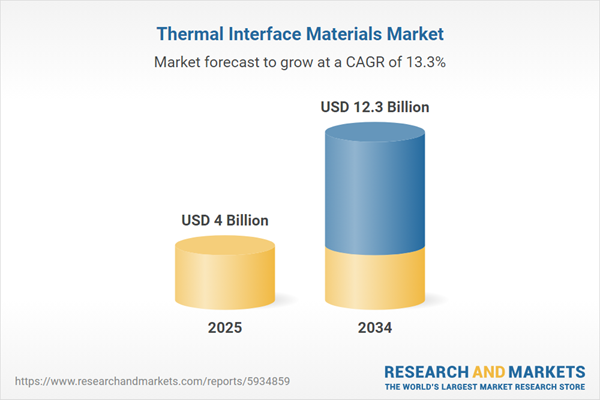Thermal Interface Materials (TIM) Market is a critical component of modern electronics, ensuring effective heat transfer between heat-generating devices and their heat sinks or spreaders. These materials, including thermal pastes, pads, greases, adhesives, phase change materials, and gels, play an essential role in maintaining optimal performance and extending the lifespan of semiconductors, LEDs, power modules, and consumer electronics. With growing demands for miniaturization, high-performance computing, and faster processing speeds, thermal management is more crucial than ever. The market has gained significant traction across industries such as automotive (particularly electric vehicles), telecom infrastructure, aerospace, and data centers, all of which require efficient dissipation of excess heat in compact and high-density electronics systems. As power densities increase and devices become more compact, the role of TIMs in thermal design becomes central to product reliability and energy efficiency.
Thermal interface materials market saw a rise in demand due to accelerated adoption of 5G infrastructure, electric mobility, and high-performance computing applications. Manufacturers focused on developing advanced formulations with higher thermal conductivity, lower thermal resistance, and long-term reliability under harsh operating conditions. Graphene- and boron nitride-based TIMs emerged as next-generation alternatives offering enhanced performance in ultra-thin and compact devices. Data centers, responding to higher server workloads, increased their use of phase-change materials and thermal pads to manage heat density and optimize uptime. The automotive sector, especially in EV battery modules and power electronics, became a major growth contributor. Sustainability also came into focus, with innovations in recyclable and low-VOC TIM products gaining interest. As devices continued to shrink and power outputs climbed, companies emphasized innovation in conformability, automation-friendly application methods, and material longevity.
Thermal interface materials market is expected to grow in tandem with next-gen technologies such as AI chips, quantum computing, autonomous vehicles, and wearable electronics. The emergence of heterogeneous packaging and 3D chip stacking will necessitate TIMs with superior thermal performance and minimal mechanical stress. Regulatory pressure for safer, non-toxic formulations and reduced environmental impact will encourage bio-based and solvent-free material development. At the same time, manufacturers will seek to integrate thermal conductivity with electrical insulation, flexibility, and miniaturization. Rapid expansion in global chip manufacturing and edge computing infrastructure will further increase demand for highly customizable TIM solutions. However, the challenge of balancing thermal performance, manufacturability, and cost-efficiency will remain a key constraint, particularly for applications in mass consumer electronics and emerging markets.
Key Insights: Thermal Interface Materials Market
- Graphene and boron nitride-based thermal interface materials are gaining momentum due to their exceptional thermal conductivity and potential for ultra-thin, high-density applications.
- Integration of TIMs in electric vehicle batteries and powertrains is expanding rapidly, driven by thermal safety and efficiency demands in energy-dense environments.
- Phase-change materials (PCMs) are increasingly adopted in data centers and telecom equipment for their ability to manage peak thermal loads and enhance reliability.
- Automation-compatible TIM solutions, including dispensable greases and printable adhesives, are streamlining high-volume production lines and reducing application variability.
- Focus on sustainability is encouraging the development of solvent-free, RoHS-compliant, and recyclable thermal interface materials for eco-friendly manufacturing processes.
- Increasing heat generation in compact electronics and high-performance computing systems is creating critical demand for efficient thermal management solutions like TIMs.
- Growth in electric vehicles and energy storage systems is driving TIM adoption in battery packs, inverters, and thermal control units for safe and efficient operation.
- Global rollout of 5G networks and expansion of data centers are fueling the need for high-performance TIMs that can sustain thermal stability in high-speed environments.
- Miniaturization and densification of semiconductor packaging, including 3D ICs, are pushing TIM performance standards to manage heat in complex, multilayered architectures.
- A key challenge in Thermal interface materials market is balancing cost, performance, and reliability - especially for mass-market applications - where premium TIMs offer superior results but may not be economically viable for large-scale deployment without process and material cost optimization.
Thermal Interface Materials Market Segmentation
By Type
- Greases & Adhesives
- Tapes & Films
- Gap Fillers
- Metal-Based TIMs
- Phase Change Materials
- Other Types
By Chemistry
- Silicone
- Epoxy
- Polyimide
- Other Chemistries
By Application
- Telecom
- Computer
- Medical Devices
- Industrial Machinery
- Consumer Durables
- Automotive Electronics
- Other Applications
Key Companies Analysed
- Henkel AG & Co. KGaA
- 3M Company
- Dow Inc.
- Parker Hannifin Corporation (Chomerics Division)
- Shin-Etsu Chemical Co., Ltd.
- Honeywell International Inc.
- Momentive Performance Materials Inc.
- Indium Corporation
- Laird Technologies (DuPont)
- Fujipoly America Corporation
Thermal Interface Materials Market Analytics
The report employs rigorous tools, including Porter’s Five Forces, value chain mapping, and scenario-based modeling, to assess supply-demand dynamics. Cross-sector influences from parent, derived, and substitute markets are evaluated to identify risks and opportunities. Trade and pricing analytics provide an up-to-date view of international flows, including leading exporters, importers, and regional price trends.Macroeconomic indicators, policy frameworks such as carbon pricing and energy security strategies, and evolving consumer behavior are considered in forecasting scenarios. Recent deal flows, partnerships, and technology innovations are incorporated to assess their impact on future market performance.
Thermal Interface Materials Market Competitive Intelligence
The competitive landscape is mapped through proprietary frameworks, profiling leading companies with details on business models, product portfolios, financial performance, and strategic initiatives. Key developments such as mergers & acquisitions, technology collaborations, investment inflows, and regional expansions are analyzed for their competitive impact. The report also identifies emerging players and innovative startups contributing to market disruption.Regional insights highlight the most promising investment destinations, regulatory landscapes, and evolving partnerships across energy and industrial corridors.
Countries Covered
- North America - Thermal Interface Materials market data and outlook to 2034
- United States
- Canada
- Mexico
- Europe - Thermal Interface Materials market data and outlook to 2034
- Germany
- United Kingdom
- France
- Italy
- Spain
- BeNeLux
- Russia
- Sweden
- Asia-Pacific - Thermal Interface Materials market data and outlook to 2034
- China
- Japan
- India
- South Korea
- Australia
- Indonesia
- Malaysia
- Vietnam
- Middle East and Africa - Thermal Interface Materials market data and outlook to 2034
- Saudi Arabia
- South Africa
- Iran
- UAE
- Egypt
- South and Central America - Thermal Interface Materials market data and outlook to 2034
- Brazil
- Argentina
- Chile
- Peru
Research Methodology
This study combines primary inputs from industry experts across the Thermal Interface Materials value chain with secondary data from associations, government publications, trade databases, and company disclosures. Proprietary modeling techniques, including data triangulation, statistical correlation, and scenario planning, are applied to deliver reliable market sizing and forecasting.Key Questions Addressed
- What is the current and forecast market size of the Thermal Interface Materials industry at global, regional, and country levels?
- Which types, applications, and technologies present the highest growth potential?
- How are supply chains adapting to geopolitical and economic shocks?
- What role do policy frameworks, trade flows, and sustainability targets play in shaping demand?
- Who are the leading players, and how are their strategies evolving in the face of global uncertainty?
- Which regional “hotspots” and customer segments will outpace the market, and what go-to-market and partnership models best support entry and expansion?
- Where are the most investable opportunities - across technology roadmaps, sustainability-linked innovation, and M&A - and what is the best segment to invest over the next 3-5 years?
Your Key Takeaways from the Thermal Interface Materials Market Report
- Global Thermal Interface Materials market size and growth projections (CAGR), 2024-2034
- Impact of Russia-Ukraine, Israel-Palestine, and Hamas conflicts on Thermal Interface Materials trade, costs, and supply chains
- Thermal Interface Materials market size, share, and outlook across 5 regions and 27 countries, 2023-2034
- Thermal Interface Materials market size, CAGR, and market share of key products, applications, and end-user verticals, 2023-2034
- Short- and long-term Thermal Interface Materials market trends, drivers, restraints, and opportunities
- Porter’s Five Forces analysis, technological developments, and Thermal Interface Materials supply chain analysis
- Thermal Interface Materials trade analysis, Thermal Interface Materials market price analysis, and Thermal Interface Materials supply/demand dynamics
- Profiles of 5 leading companies - overview, key strategies, financials, and products
- Latest Thermal Interface Materials market news and developments
Additional Support
With the purchase of this report, you will receive:- An updated PDF report and an MS Excel data workbook containing all market tables and figures for easy analysis.
- 7-day post-sale analyst support for clarifications and in-scope supplementary data, ensuring the deliverable aligns precisely with your requirements.
- Complimentary report update to incorporate the latest available data and the impact of recent market developments.
This product will be delivered within 1-3 business days.
Table of Contents
Companies Mentioned
- Henkel AG & Co. KGaA
- 3M Company
- Dow Inc.
- Parker Hannifin Corporation (Chomerics Division)
- Shin-Etsu Chemical Co. Ltd.
- Honeywell International Inc.
- Momentive Performance Materials Inc.
- Indium Corporation
- Laird Technologies (DuPont)
- Fujipoly America Corporation
Table Information
| Report Attribute | Details |
|---|---|
| No. of Pages | 160 |
| Published | October 2025 |
| Forecast Period | 2025 - 2034 |
| Estimated Market Value ( USD | $ 4 Billion |
| Forecasted Market Value ( USD | $ 12.3 Billion |
| Compound Annual Growth Rate | 13.2% |
| Regions Covered | Global |
| No. of Companies Mentioned | 10 |









